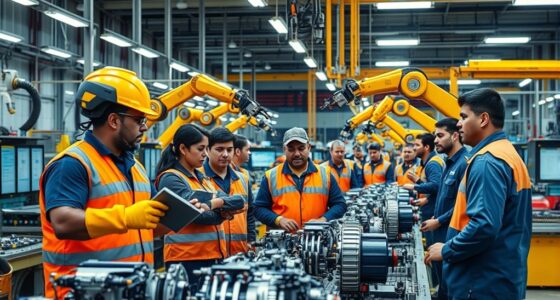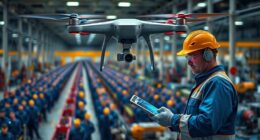Some countries face bigger job losses from automation because of sector vulnerabilities, workforce skills, and differences in policy responses. Industries like manufacturing and energy in many regions are more susceptible, especially where automation replaces manual tasks. Geographic disparities also play a role, with advanced economies more enthusiastic to adopt AI and robotics, risking higher disruptions. If you explore further, you’ll discover how nations are managing these risks and shaping resilient strategies for the future.
Key Takeaways
- Countries with higher manufacturing reliance and lower workforce skills face greater job losses from automation.
- Northern European nations lead in AI impact, while Southern and Eastern Europe lag due to skill gaps and sectoral differences.
- Economies with advanced robotics adoption, like Korea and Singapore, experience more significant automation-driven employment shifts.
- Policy differences, such as investments in reskilling and safety nets, influence how countries mitigate automation’s job impacts.
- Regions dependent on vulnerable sectors like energy and retail are more exposed to larger employment disruptions.
The Scope of Automation Disruption Across Industries
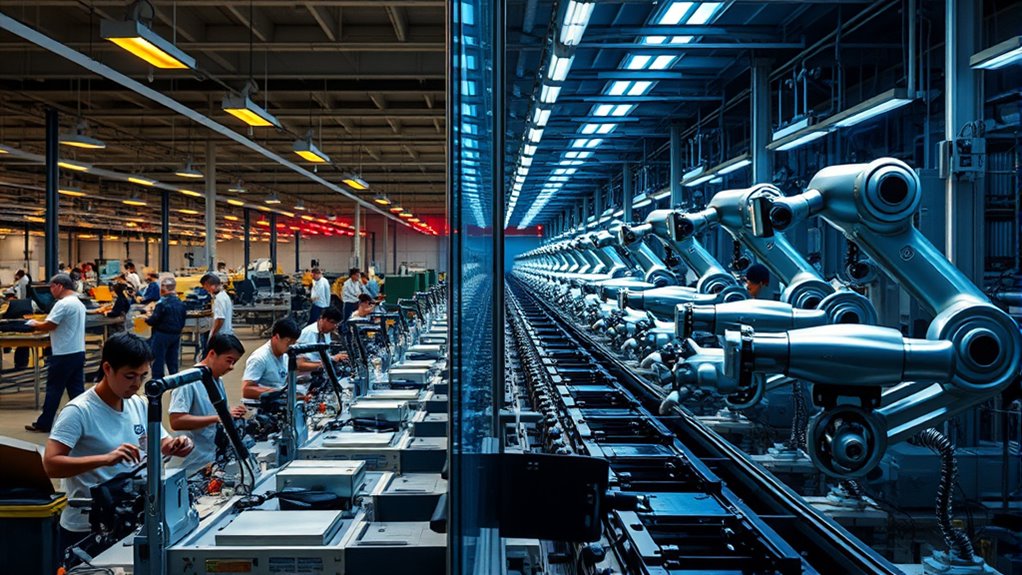
Automation is transforming industries at different rates and with varying impacts. In manufacturing, your job is most exposed, as over half of workers use automation technologies like robots and AI. These tools replace routine tasks efficiently, often replacing 1.6 workers per robot. The increasing adoption of automation tools reflects ongoing technological advancements that continue to reshape employment landscapes. Studies show that the routine task profile of an industry heavily influences its vulnerability to automation. Additionally, the technological sophistication of a sector determines how easily automation can be integrated, affecting overall job security. The cost of implementation also plays a role in how quickly industries adopt automation solutions, influencing employment shifts. Moreover, the adaptability of the workforce can impact how well industries manage these transitions and retrain employees. Service industries such as transport, maintenance, and construction also face significant disruption, especially where manual and repetitive tasks dominate. In contrast, industries requiring higher education or specialized skills are less vulnerable, as complex problem-solving and interpersonal skills remain harder to automate. Globally, millions of jobs could vanish by 2030, with manufacturing alone risking up to 20 million job losses. The extent of automation’s impact depends heavily on the industry’s routine task profile, shaping future employment landscapes across sectors. 60% of companies currently utilize automation tools in workflows (Duke University).
Geographic Disparities in Automation Adoption

Regions vary considerably in how quickly they adopt AI technologies, influenced by factors like infrastructure, industry composition, and government policies. Northern European countries lead in AI impact, while Southern and Eastern Europe lag behind due to sectoral differences, such as less reliance on AI-driven industries like manufacturing and agriculture. Digital infrastructure, like broadband access, doesn’t directly determine adoption rates; workforce skills and sectoral structures play a bigger role. Countries with lower AI adoption often use policies to boost productivity without risking job losses. Meanwhile, regions with lower AI integration have opportunities to proactively adopt AI to enhance growth. Juice benefits Overall, geographic disparities shape how automation affects employment, with some areas positioned to benefit more than others based on their unique economic and policy landscapes.
Economic Factors Shaping Job Loss Risks
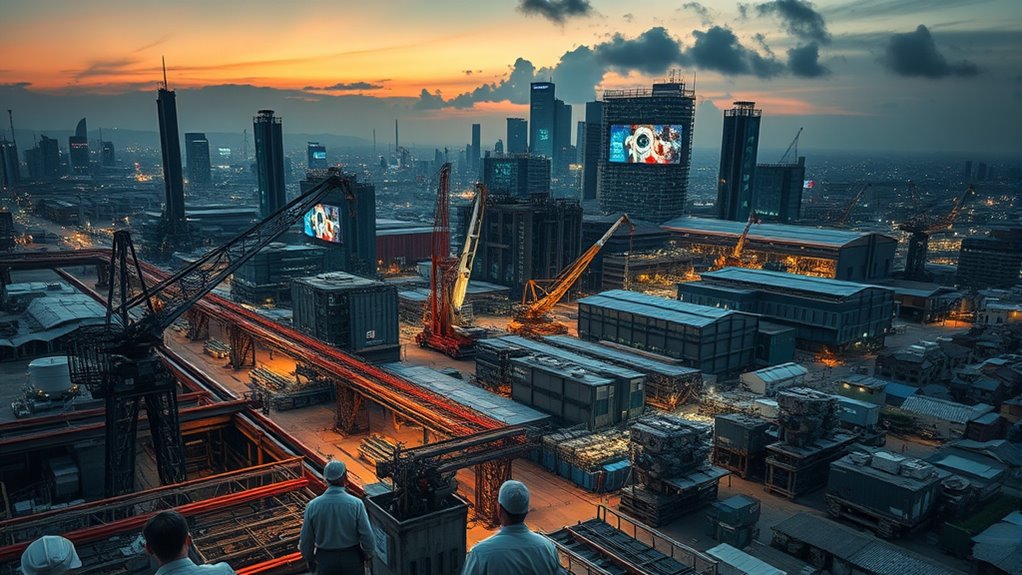
Your country’s reliance on manufacturing makes it more vulnerable to job losses from automation, especially if many roles are easily replaceable. Investment in automation technologies can accelerate displacement but also create new opportunities if managed well. A strong social safety net helps cushion workers during shifts, reducing economic and social fallout. Additionally, countries with robust social protections are better positioned to manage the social impacts of automation. Global trends indicate that countries with less developed social protections may face more severe social instability due to automation-related job disruptions.
Economic Dependency on Manufacturing
Economic dependency on manufacturing considerably influences job loss risks, as countries and regions that rely heavily on this sector are more vulnerable to economic shifts. If your economy depends markedly on manufacturing, downturns like trade deficits or global supply chain disruptions hit hard, causing substantial job losses. For example, in the U.S., manufacturing employment peaked around 1970 but declined over decades, with notable losses during recessions. Although recovery has occurred, manufacturing still accounts for only 9.7% of the private workforce in 2023. Regions with high manufacturing reliance experience more pronounced economic impacts during downturns, making diversification essential. Countries that shift toward service-oriented economies or diversify sectors tend to be better protected against the risks associated with heavy manufacturing dependence. Diversification of economic sectors helps mitigate vulnerability and promotes more resilient economic growth. Additionally, investing in economic resilience strategies can further strengthen a country’s ability to withstand sector-specific downturns and ensure sustainable development. Implementing policies that encourage innovation and workforce adaptability can also reduce manufacturing sector reliance and support long-term economic stability. Moreover, diversifying the industrial base can help create a buffer against sector-specific shocks, safeguarding employment and economic stability. Developing a skilled workforce through targeted training programs can also enhance adaptability and reduce dependency on traditional manufacturing jobs. Incorporating advanced manufacturing technologies can also boost productivity and reduce vulnerability to traditional industry declines.
Investment in Automation Technologies
Investment in automation technologies is rapidly transforming industries worldwide, driven by increasing market demand, technological advancements, and supportive government policies. Countries like Korea and Singapore lead in robot density, with Korea having 1,012 robots per 10,000 employees. In 2021, global spending on intelligent process automation reached $10.9 billion, while 68% of major companies plan to boost cybersecurity automation investments. China saw a 45% rise in industrial robot installations that year, and Germany commands over 30% of Europe’s robot market. Governments, such as France, have introduced stimulus packages to fund smart factory upgrades. As technological progress makes automation more cost-effective, companies invest to stay competitive. Regions like Asia and Europe prioritize automation to fuel economic growth and maintain their market positions. Rapid growth in robot adoption underscores the urgency for nations to adapt to this shifting landscape. Additionally, the integration of appliance maintenance plans and smart home automation services can support the effective deployment of new technologies across industries. Furthermore, understanding the trustworthiness of automation providers is crucial for ensuring successful and secure implementation. Recognizing the importance of regulatory compliance helps companies navigate legal requirements and avoid potential penalties. Staying informed about the cost-effectiveness of automation can help businesses optimize their investments and operational efficiency. Embracing tuning strategies can also optimize performance and efficiency in automated systems.
Social Safety Net Strength
As automation accelerates and AI threatens to displace millions of workers worldwide, the strength of social safety nets becomes increasingly crucial. These programs, covering about 2.5 billion people globally, help vulnerable populations, especially the poorest quintile. They include unemployment insurance, cash transfers, and other supports that cushion economic shocks. During crises like COVID-19, these safety nets expand to protect workers. Effective safety nets can buffer the health and wellbeing impacts of job loss, but gaps remain—particularly for the most vulnerable. Vetted policies and programs are essential to ensure the sustainability and adequacy of these safety nets in the face of rapid technological change, especially given the diverse coverage levels across different countries. Additionally, integrating digital platforms can enhance the delivery and efficiency of social safety programs, making them more accessible to those in need. Recognizing the importance of data analysis in optimizing resource allocation can further improve the responsiveness of social safety systems. Moreover, leveraging alternative investments like Gold IRA options could be considered by some countries as part of their economic resilience strategies in uncertain times.
Sector-Specific Vulnerabilities and Opportunities
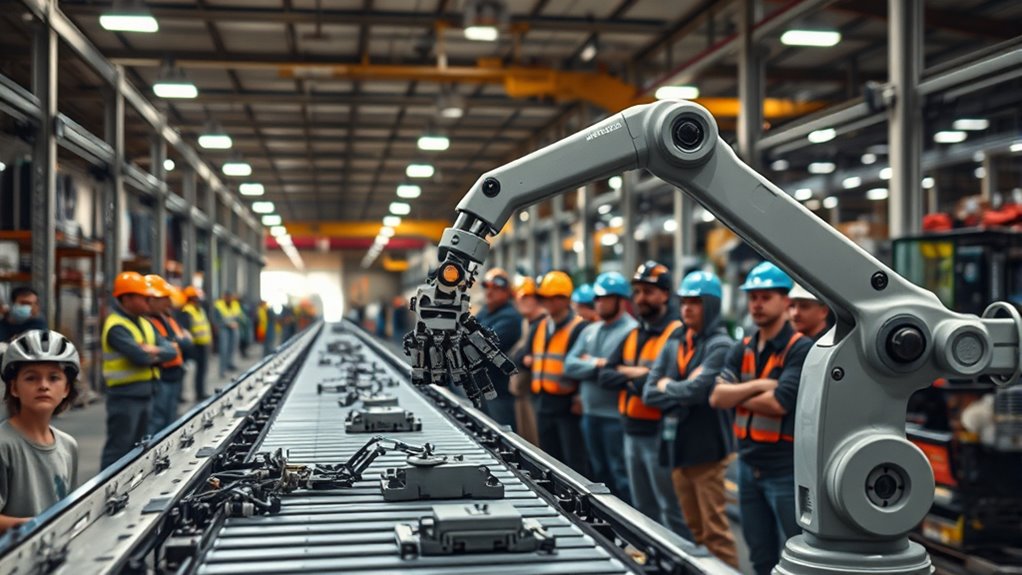
Different sectors experience unique impacts from automation, creating both vulnerabilities and opportunities. In manufacturing, 1.7 million jobs have vanished since 2000, mainly due to robotics and AI replacing repetitive tasks. Wages have plummeted, but reskilling for robot maintenance and higher-value roles can turn challenges into opportunities. The energy, utilities, and mining sectors risk nearly half their jobs by 2030 but can benefit from AI-driven safety and efficiency upgrades. Additionally, embracing adaptability is crucial for workforce resilience in these evolving industries. Developing effective communication skills and emotional intelligence can help workers navigate industry changes more smoothly. Investing in workforce development programs is essential to address these shifts effectively. Recognizing the importance of technological literacy can further empower workers to adapt to rapid industry changes. Retail faces automation threats to 41 million jobs, yet new roles in data analytics and logistics emerge. The IT and telecom sectors see layoffs from AI-driven automation, but they also open doors for specialized tech roles. Clear communication and emotional intelligence are essential for navigating these sector transformations and workforce transitions. Here’s a snapshot of sector impacts:
| Sector | Vulnerabilities | Opportunities |
|---|---|---|
| Manufacturing | Job displacement, wage decline | Reskilling, high-value manufacturing |
| Energy & Utilities | Job loss, safety risks | AI safety tools, green tech jobs |
| Retail | Job cuts, operational costs | Data, logistics, hybrid roles |
Workforce Resilience and Adaptation Strategies

To strengthen your workforce against automation, focus on reskilling and upskilling efforts that build versatile skills. You should also consider policies and social safety nets that support workers through shifts. By adopting these strategies, you can foster resilience and secure your team adapts effectively to technological change.
Reskilling and Upskilling Efforts
In response to rapid technological changes, companies and governments are actively investing in reskilling and upskilling efforts to build workforce resilience. You’re encouraged to embrace these initiatives, which are increasingly personalized through AI-driven tools, making learning more effective. Collaborations between industry and educational institutions are creating curricula aligned with new job demands. Over 77% of employers plan to train workers to work alongside AI, highlighting a collective push to adapt. Awareness of automation’s impact motivates proactive strategies, including regular risk assessments and industry-specific training. The global human augmentation market’s growth signals new opportunities to enhance worker capabilities.
- Feel the hope in new training pathways that empower you to stay relevant.
- Recognize the importance of continuous learning to secure your future.
- Embrace the collaboration shaping tailored skills for emerging roles.
- Know your resilience is built through proactive, strategic reskilling efforts.
Policy and Social Safety Nets
Policy and social safety nets are essential tools for building workforce resilience amid automation. They help cushion job losses and support workers *shifting into* new roles. Strong unemployment insurance reduces income instability, while universal healthcare detaches health coverage from employment, easing economic insecurity. Pilot programs like universal basic income show promise in stabilizing poverty. Wage subsidies and job retention schemes smooth rapid automation *shifts*. Digital platforms enable faster benefit delivery, improving access. Here’s a quick overview:
| Policy/Mechanism | Impact |
|---|---|
| Unemployment insurance | Reduces income volatility |
| Healthcare coverage | Mitigates economic insecurity |
| Universal basic income | Stabilizes poverty |
| Wage subsidies/retention schemes | Supports job continuity |
| Digital benefit platforms | Enhances support accessibility |
The Role of Social Safety Nets and Policy Responses

As automation accelerates and transforms the labor market, social safety nets and policy responses become essential tools for mitigating job losses and ensuring economic stability. You need thorough safety nets to protect workers affected by automation and AI. Redistributing some of the value generated can help ease economic disparities. Offering retraining programs is vital for vulnerable workers to adapt to new roles. These measures can reduce rising wage inequality and provide a safety buffer during transition periods.
- Feel the relief of knowing support is available during uncertain times
- Witness how fair policies can rebuild trust in progress
- Experience hope as retraining opens doors to new careers
- Recognize that collaborative efforts can protect livelihoods and foster resilience
Emerging Trends in Human Augmentation and Robotics

Advancements in human augmentation and robotics are transforming industries and everyday life by blending cutting-edge AI with physical systems. AI now enhances robots’ decision-making, problem-solving, and workflow efficiency, while virtual training enables experiential learning beyond traditional programming. Generative AI approaches aim for flexible, adaptive behaviors similar to breakthroughs like ChatGPT. Robots can process natural language and complex data, making human interaction more intuitive. Collaborative robots, or cobots, work safely alongside humans, learning tasks autonomously and adjusting behavior via sensors to prevent accidents. Humanoid robots are improving in mobility, dexterity, and emotional understanding, expanding roles in caregiving, education, and customer service. Medical and hazardous environment robotics, including surgical and remote caregiving systems, demonstrate increasing precision and safety, advancing human augmentation across critical sectors.
Challenges and Opportunities for Developing Economies

Emerging innovations in human augmentation and robotics are reshaping industries worldwide, but their benefits aren’t evenly distributed. Developing economies face unique challenges—they often lack the infrastructure and skilled workers needed to adopt AI effectively. Without clear strategies, they risk falling further behind as automation widens the skills gap and deepens economic inequality. Low-skilled workers are especially vulnerable, struggling to adapt to rapid technological changes, which can lead to stagnant wages and job losses. However, there are also opportunities. Investing in digital infrastructure and education can open AI’s potential for growth, innovation, and new job sectors.
- Facing the risk of being left behind, you must prioritize strategic AI planning.
- Building digital skills can empower your workforce to stay competitive.
- Infrastructure investments are key to bridging the technological divide.
- Embracing AI can spark economic growth and new opportunities.
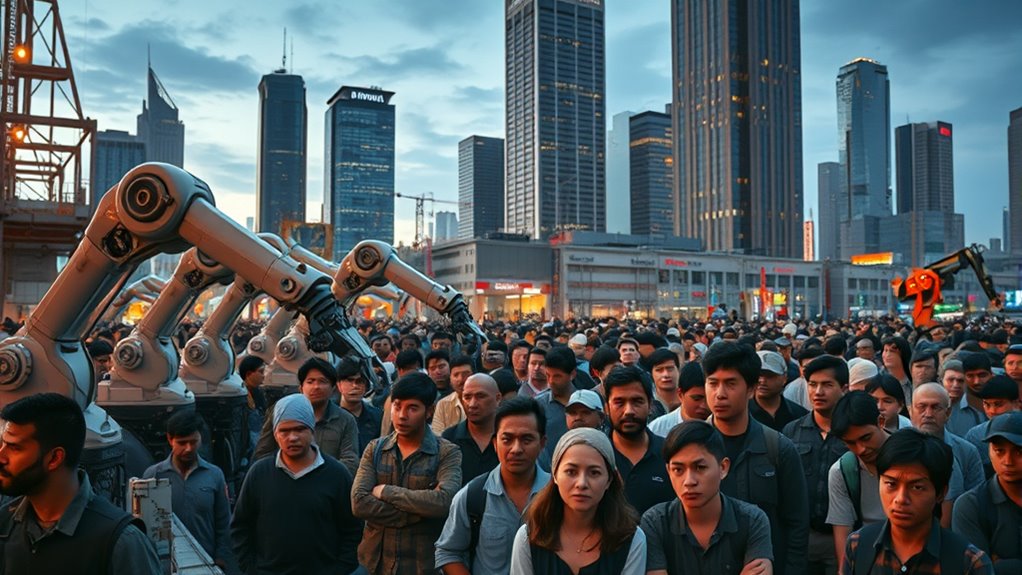
The future of work is set to be reshaped dramatically by automation, with projections indicating that by 2025, 85 million jobs worldwide will be disrupted, mainly in medium and large businesses across various industries. You’ll see AI tools like ChatGPT and AI agents automating more tasks, increasing efficiency but also raising fears of job loss—30% of workers worry about being replaced by AI by 2025. Advanced economies face a higher risk, with 60% of jobs potentially at stake. To navigate this divide, you’ll need to focus on reskilling and upskilling, especially in decision-making, reasoning, and communication. Continuous learning and strategic investment in education will be essential, fostering collaboration between humans and machines to adapt to the evolving landscape of employment.
Frequently Asked Questions
How Will Automation Impact Income Inequality Globally?
You might wonder how automation will affect income inequality worldwide. It’s likely to widen gaps, as automation favors high-skilled workers and boosts capital income, leaving low-wage workers behind. Countries with better access to education and technology could see more benefits, while others face greater disparities. To address this, you need policies that promote inclusive growth, invest in skills, and guarantee fair distribution of automation’s gains.
Which Countries Are Best Prepared for Automation-Related Job Transitions?
You’re wondering which countries are best ready for automation shifts. Australia leads with a 72% preparedness score, meaning it’s more equipped to handle job changes through reskilling and policies. In contrast, India and Pakistan lag behind at around 44% and 40%. Countries with high robot deployment and strong employer expectations, like Japan, the US, and China, are also better positioned to manage automation’s impact effectively.
What Industries Will Benefit Most From Automation Advancements?
You’ll find that manufacturing, healthcare, finance, and logistics benefit most from automation advancements. Manufacturing gains precision and cost savings, healthcare improves diagnostics and surgeries, finance streamlines processes and enhances security, while logistics boosts efficiency and delivery accuracy. These industries leverage automation to reduce errors, speed up operations, and cut costs, giving them a competitive edge. Embracing automation in these sectors can lead to significant productivity increases and better service delivery.
How Can Governments Effectively Support Displaced Workers?
You should understand that governments can support displaced workers through programs like TAA, offering retraining, income support, and job search help. Expanding eligibility and streamlining access are vital. Investing in sectoral training, apprenticeships, and regional development can create new opportunities. Legislation like the TAA for Automation Act can also extend assistance. By combining these strategies, you can help workers shift smoothly into new roles amid automation-driven changes.
Will Automation Create More Jobs Than It Destroys Long-Term?
You wonder if automation will ultimately generate more jobs than it destroys. While robots and AI might eliminate millions of roles, they also create new opportunities in tech, innovation, and industries we haven’t yet imagined. If you stay adaptable, sharpen your skills, and embrace change, you position yourself to benefit from this balance. Long-term, automation can be an ally, turning transformation into a tide of opportunity rather than an obstacle.
Conclusion
As automation accelerates, some nations face a future of job losses, like a storm sweeping across a fragile landscape. Yet, others build resilient forests through adaptable skills and supportive policies. While gaps widen, opportunities emerge for those willing to innovate and invest in human-robot collaboration. Your challenge is to navigate this divide—transforming potential chaos into a landscape of new growth and promise.




